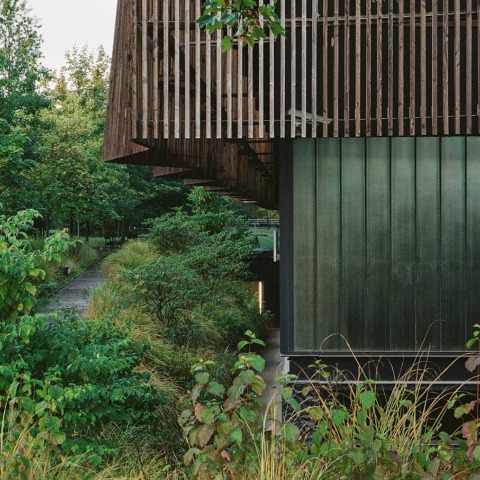"Le bois dont on fait les villes / The wood that makes our cities" also deals with issues related to the impact of deforestation processes or pollution in the means of production and transport on the environment.
Description of project by Leclercq Associés
Wood: Opening Up the Possibility of a Bond Between the Land and Contemporary Construction
The Wood That Makes Our Cities explores the environmental, economic, industrial, and technical challenges involved in the use of wood for large structures and urban architecture. The book also assesses the future of wood construction. Is the French wood industry sufficiently well-established to advance centuries-old techniques and develop alternatives to standard models? Do sensible forestry practices provide sustained capacity to meet demand and compete with resinous timber imports from Northern Europe?
Despite the paradoxical context in France, home to a wealth of ancient expertise with an industry that has been struggling for the past four decades, The Wood That Makes Our Cities shows that there are solutions for economic growth being implemented in the Rhône-Alpes region, thanks to relentless local industry professionals.
‘‘A quintessentially traditional material, wood today is revered almost as sacred and is viewed as a miracle solution to tackle climate issues and make the construction industry greener. But wood is so much more: it is a clever material, accessible to all, and with the potential to solve contemporary urban challenges. Additionally, it is compatible with approaches emphasizing strong local ties, and presents an opportunity to rejuvenate regional production networks.’’
François Leclercq, architect and urban planner.
‘‘Wood has found its place into architectural production and will long remain a token of a sustainable industry: local, decarbonized, inventive and architecturally inspiring.’’
Paul Laigle, architect and partner
The Rise of a Green Wave
Wood is the ideal construction material for sustainable architecture. But how is each supply sourced, and how do we make sure that our forestry practices and transformation processes are relevant for the future? How does using wood challenge traditional notions of trade expertise and qualifications in architecture, engineering, and construction? This field survey provides insight into the current change in paradigm brought on by urban policies that affect both the construction industry and project designers.
‘‘We are seeing the emergence of resilient architecture, with a new generation of buildings with carbon-sequestering structures and frames, thereby addressing one of the conditions for transitioning to sustainability. Used in cities since ancient times, wood is now gaining ground in modern cities on a large scale thanks to innovative technologies facilitating the implementation of the material.’’
Michèle Leloup, architecture editor
A pioneer of high-profile sports and education architecture at the turn of the millennium, Leclercq Associés present in this book five major wood construction projects deeply rooted in their environment: the Lycée Jean-Baptiste Corot in Savigny-sur-Orge (2000-2009), the INSEP sports campus in Paris (2005-2014), the Lycée Nelson Mandela on the Île de Nantes (2011-2014), the Arboretum ecocampus in Nanterre, and Sous Le Signe Du Bois, a residential complex in Vélizy-Villacoublay. Serving as a starting point for the book, Cyrille Weiner’s photographs of these buildings shed light on the issues faced by the wood industry as it struggles to address multiple challenges relating to the environment, the economy, forestry, manufacturing, and construction.
When Photography Sparks the Debate A producer of editorial objects driven by years of experience, Cyrille Weiner is regularly joined in his projects by Jad Hussein, who shares the same intellectual and emotional perspective on books, making each publication a one-off object. Initiated by the work of Cyrille, who has photographed the practice’s most iconic projects, the debate on the prospects of this construction method resonated with François Leclercq and Paul Laigle. Both of them were keen on opening up a discussion on a major trend that is forcing us to rethink the true environmental dimension of tomorrow’s cities.
































